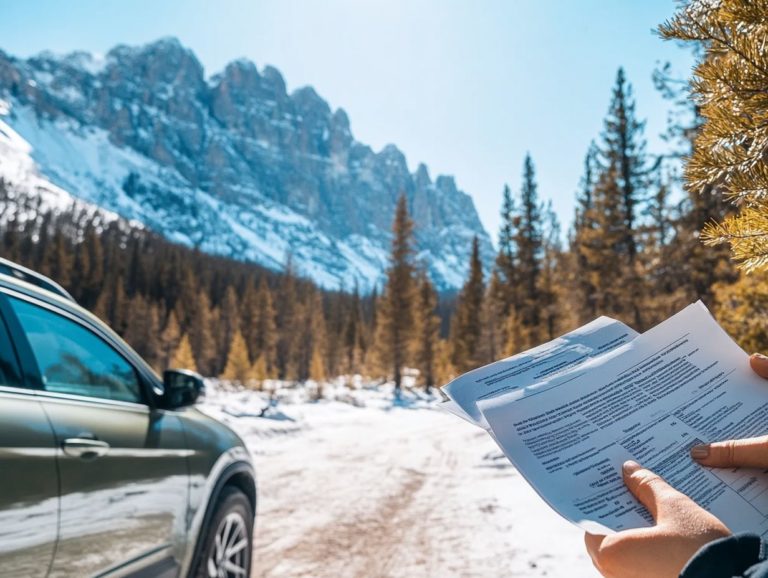New York Auto Insurance: Unraveling the Basics
Navigating the realm of auto insurance in New York can indeed feel overwhelming, especially given its unique regulations and myriad coverage options.
It s essential for you to grasp the minimum coverage requirements and familiarize yourself with the various policy types available, ranging from liability to comprehensive coverage.
This article will break down the key factors influencing insurance rates, provide tips for securing the best deals, and clarify the claims process, ensuring that you re thoroughly equipped to make informed decisions regarding your auto insurance needs.
Contents
Key Takeaways:

- New York requires drivers to have minimum liability insurance, but additional coverage like collision and comprehensive can provide more protection.
- Factors like driving record, vehicle type, and location can affect auto insurance rates in New York.
- When shopping for auto insurance in New York, be sure to compare quotes and ask about available discounts to get the best coverage for your needs and budget.
Understanding Auto Insurance in New York
Understanding auto insurance in New York demands a clear understanding of its multifaceted components. This includes not only the various types of coverage available but also the minimum limits mandated by law.
The auto insurance landscape in New York is distinctly shaped by its unique regulations and economic conditions. These factors can substantially influence your premiums and policy options.
Drivers must recognize the importance of liability insurance, personal injury protection (PIP), and uninsured motorist coverage. These elements are crucial for protecting yourself from the financial impact of accidents. Don’t underestimate their importance!
Overview of Insurance Coverage
The insurance coverage landscape in New York includes several vital types that are essential for your protection, such as liability insurance, personal injury protection (PIP), and uninsured motorist coverage. Each of these is tailored to shield you and your passengers from the various scenarios that can arise on the road.
These policies are essential when it comes to alleviating the financial strains that often accompany car accidents. Liability insurance, for instance, covers damages to another person’s property and their medical expenses if you’re found at fault in an accident. On the other hand, PIP covers your own medical costs and those of your passengers, regardless of who caused the mishap.
Uninsured motorist coverage is particularly crucial, ensuring you’re protected if the other driver lacks insurance an all-too-common situation on the roads today. You might also consider additional options like collision coverage, which helps you repair your car after an accident, or comprehensive insurance, which covers events like theft or natural disasters.
For married couples, spousal liability coverage offers an extra layer of protection, while gap insurance is a must if you owe more on your vehicle than its current market value. This way, you can navigate unforeseen circumstances with a sense of peace and security.
Minimum Coverage Requirements
Understanding the minimum coverage requirements in New York, as set by the New York State Department of Motor Vehicles, is essential for every driver to meet their legal obligations. These requirements specify the baseline limits for liability insurance, which are critical for addressing bodily injury and property damage stemming from vehicle accidents.
It is imperative for you to consult licensed insurance agents to ensure compliance with these legal standards and to select a risk plan tailored to your specific needs. Make sure you understand these requirements today to stay protected on the road!
Legal Requirements for Drivers in New York
In New York, legal requirements dictate that every vehicle owner must maintain a valid insurance policy that includes liability coverage meeting the state s minimum limits. This means that, beyond basic liability coverage which shields you from damages inflicted on others in an accident you are also required to carry additional protections.
Among these is Personal Injury Protection (PIP), which helps cover your medical bills and lost wages for you and your passengers, regardless of fault in an accident. Uninsured motorist coverage is also required, ensuring you re financially protected if you find yourself in an accident with someone lacking liability insurance.
Meeting these legal requirements keeps you safe and secure on the road!
Types of Auto Insurance Policies

The array of auto insurance policies in New York includes liability, collision, and comprehensive coverage. Each type is designed to address specific risks and provide financial protection for drivers.
In this competitive insurance landscape, grasping the nuances of each policy type is crucial. Liability insurance shields you against damage claims, collision coverage covers vehicle damage from accidents, and comprehensive coverage protects you from incidents that don t involve a collision.
To ensure you select the most fitting policy for your needs, consider consulting with certified brokers who can guide you through the options available.
Comparing Liability, Collision, and Comprehensive Coverage
When you compare liability, collision, and comprehensive coverage, it’s essential to grasp how each type of insurance tackles different risks and offers financial protection in the event of an accident.
Liability coverage specifically safeguards you from the costs associated with damages or injuries you might cause to others, effectively covering third-party claims. In contrast, collision coverage kicks in when you face expenses related to your vehicle’s repairs after an accident, regardless of who s at fault. Comprehensive coverage takes it a step further by protecting you against non-collision events, such as theft, vandalism, or natural disasters.
Each type of insurance carries its unique advantages and potential limitations. Therefore, it is crucial for you to assess your specific needs. Insurance professionals are essential in this journey, guiding you to select the optimal coverage based on your driving habits, budget, and potential risks you may encounter on the road.
Factors Affecting Auto Insurance Rates in New York
Several factors can profoundly influence your auto insurance rates in New York. Your overall driving record, the prevalence of insurance fraud, and the risk plan you choose all play significant roles.
Insurers use a multi-tier rating system, which is a method to assess different levels of risk based on your driving history, that evaluates various risk factors, including your history of accidents, claims made, and even the type of vehicle you re insuring.
By grasping these elements, you can empower yourself to make informed choices that may help lower your insurance costs and reduce potential economic losses.
Key Considerations for Premiums
When you re considering premiums for auto insurance, several key factors come into play, including your past driving record, the risk plan offered by the insurance company, and the overall landscape of auto insurance rates in New York.
Your driving history matters past incidents like accidents or traffic violations can significantly affect how much you pay in premiums. Insurance companies assess risk plans that outline various levels of coverage, which directly influences your costs. Elements such as your vehicle type, mileage, and even your credit history can all play a role in how insurers determine your rates.
To keep those premiums in check, you can shop around for competitive quotes and think about bundling policies. By understanding the cost implications of different coverage options, such as liability versus comprehensive insurance, you can make more informed choices that align with your personal budgeting and risk tolerance.
Start comparing quotes today to find the best deal for your needs!
Tips for Finding the Best Auto Insurance in New York
Finding the best auto insurance in New York requires a strategic approach. Shopping for quotes and uncovering discounts can notably reduce your premiums. Working with certified brokers helps you navigate various options and customize your coverage to fit your needs and budget.
Comparing policies can lead to significant savings and coverage that aligns perfectly with your driving habits. Don t miss out on potential savings!
Shopping for Quotes and Discounts

Shopping for quotes and discounts is essential for securing affordable auto insurance. It allows you to compare premiums from different insurance companies and find the best rates available.
By reaching out to multiple insurers, you gain valuable insights into different policy offerings, coverage options, and deductible amounts (the amount you pay out of pocket before insurance kicks in). Ask about potential discounts for safe driving, bundling policies, or participating in reward programs.
Utilizing a certified broker can enhance your experience. Brokers have in-depth knowledge of the insurance market and can spot savings opportunities that might not be obvious. Engaging in thorough comparisons helps you discover the most favorable pricing and ensures you receive comprehensive coverage tailored to your needs.
Understanding Claims and Coverage Limits
Understanding claims and coverage limits is crucial for drivers, especially after an accident. It ensures you receive the financial protection promised by your insurance policy.
Knowing how to file a claim is key to getting your benefits. Being aware of your coverage limits helps you manage your expectations regarding liability insurance and any potential economic losses from accidents.
What to Know About Filing a Claim and Policy Limits
When it comes to filing a claim and understanding policy limits, being well-informed about the claims process dramatically influences your insurance experience.
To navigate this process smoothly, gather necessary documentation, including accident reports, photographic evidence, and relevant medical records. Once you have these materials, promptly contact your insurance provider; delays can jeopardize your case.
Clearly outline the details of the incident, ensuring that the information aligns with your policy’s terms.
Understanding policy limits is crucial, as these dictate the maximum payout and directly impact your financial recovery. Knowing how liability insurance plays into the claims process clarifies coverage responsibilities, providing you with peace of mind during a stressful situation.
Frequently Asked Questions
What is New York auto insurance?
New York auto insurance provides financial protection for drivers in New York. It is required by law for all drivers to have at least a minimum amount of auto insurance coverage to legally operate a vehicle.
What does New York auto insurance cover?

New York auto insurance typically covers damages or injuries from car accidents, as well as any legal expenses that may arise. It can also provide coverage for theft, vandalism, and other types of damage to your vehicle.
How much auto insurance coverage do I need in New York?
In New York, the minimum amount of auto insurance coverage required by law is $25,000 for bodily injury per person, $50,000 for bodily injury per accident, and $10,000 for property damage. However, it is recommended to have higher coverage limits to ensure adequate protection.
What factors can affect the cost of my New York auto insurance?
Several factors affect the cost of your New York auto insurance. These include your age, driving history, type of vehicle, and where you live.
Your chosen coverage amount and deductible also impact your insurance cost.
Can I get discounts on my New York auto insurance?
Yes! Many insurance companies offer discounts for various reasons. For instance, you may qualify for savings if you have a clean driving record or complete a safe driving course.
Always ask your insurance provider about potential discounts you might qualify for.
What happens if I drive without auto insurance in New York?
Driving without auto insurance in New York is a serious offense. It can lead to fines, license suspension, and even jail time.
Don’t take the risk! Make sure you have adequate coverage before getting behind the wheel.




